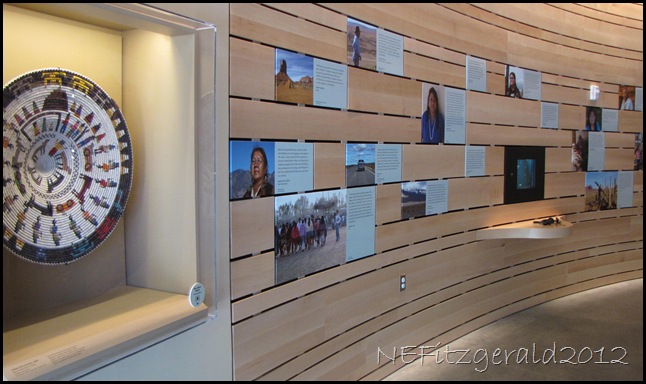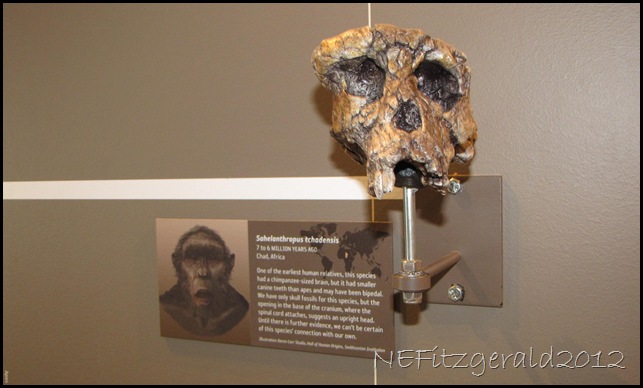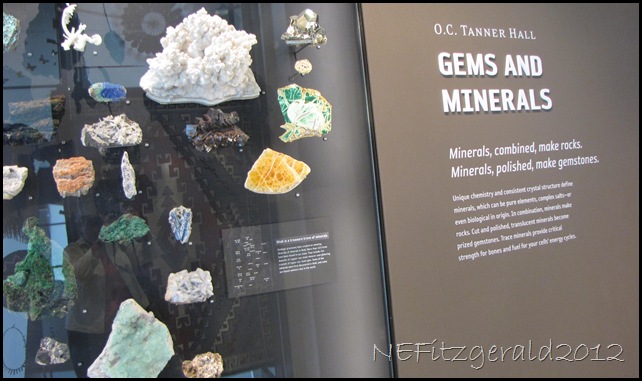The Utah Museum of Natural History in Salt Lake City has recently moved into its new home high on the foothills of the Wasatch Mountains. Since I was going to be in the city for a few days on my way to Yellowstone, I decided to stop in and have a look around. I hatched a big–city plan to take Trax light rail from my deluxe downtown couch–surfing accommodations in the morning, wander around the museum for several hours, hop back on Trax, and catch a late afternoon movie.
2012
 |
| Level 3 walkway at the Museum of Natural History leads to First Peoples gallery |
My nephew offered detailed instructions to his aunt from the suburbs concerning how to get to the Trax station from the comfort of his couch (“Go out the door. Turn left. Walk two blocks. Buy ticket. Get on.”). I was born driving a car and pride myself on being able to easily maneuver any interstate malfunction junction or back road construction zone. But I was a bit out of my comfort zone using public transportation. However, I was confident I could pull this off.
The entire inbound journey involved backtracking two stops on Trax, riding the wrong connecting bus, and walking roundaboutly for nearly a mile uphill while being accompanied by a cheerful chemistry major, but I finally arrived at my destination.
By the time I got to the museum it was nearly noon. I was exhausted!
By the time I left I was impressed by both the architecture of the building and by the quality of the exhibits. Like at any large museum, it is impossible to see everything in one day. I had to pick and choose carefully.
The woman who sold me my ticket recommended I go up to Level Five and start on the Sky Terrace and work my way back down. It was excellent advice.
 |
| Rooftop solar panels provide 25% of the museum’s power |
On the roof of the museum, 1378 solar panels generate electricity that help power the exhibits. Rooftop plants such as Bailey’s Gold Stonecrop, Sea Thrift, and Purple Carpet Creeping Thyme have several functions – they insulate the building, provide habitat for birds and insects, and filter water and air.
 |
| A story of survival |
Native Voices gallery reminds us of people who once moved with the seasons across vast western territories and who have “always been here.” In the past they faced not only trade and diplomacy but also warfare, confinement, betrayal, dispossession and impoverishment.
Today, traditional values give meaning and balance to adaptations of a 21st century world. Stories of loss and aspirations are shared as new choices and new dreams.
 |
| New Choices, New Dreams |
The web of life that intertwines our world is astounding. In the Life gallery, a series of exhibits focuses on the extraordinary biological diversity found in Utah.
 |
| The web of Life |
How do we know that the human lineage is so ancient? How do we relate six or seven million year old skull fragments found in a remote rocky wash in Africa to ourselves as Homo sapiens? In Our Family Tree we find compelling evidence for the answers to these enigmatic questions.
 |
| From left to right, a history of humankind in bone |
 |
| I found the story of Sahelanthropus tchadensis fossils to be most intriguing |
We have only skull fragments of Sahelanthropus tchadensis, but the opening at the base of the skull where the spinal cord attaches suggests that this early species walked upright. An expansion of the tibia or shin bone in four million year old Australopithecus anamensis from sites in Kenya and Ethiopia indicates bipedal walking – its legs could support its body weight on one leg at a time. I found this detail absolutely amazing. Additionally, its teeth resemble those of humans more than chimpanzees.
The Land gallery takes the visitor through the landscape that is Utah. The Middle Rocky Mountains, Basin and Range, and Colorado Plateau all converge in tectonic array and geologic wonderment.
Of course there was a dinosaur exhibit. These creatures are found practically everywhere in Utah!
 |
| From tiny to huge, Utah has them all |
I spent too little time with First Peoples and the archeological evidence of their existence in the Great Basin region beginning some 13,000 years ago.
 |
| “We have always been here.” |
Utah is home to a startling array of minerals and many examples are on display along with samples from around the world. The collection was much too small for my tastes, though. I had hoped it would take up an entire wing.
 |
| Minerals and their gemstones |
Sadly, reflection on the display case glass was a serious buzzkill for taking any decent photographs of individual minerals. To make up for this sad situation I found the examples of the various crystal shapes found in nature to be superb.
 |
| Did you know that pyrite crystals can be cubic, dodecahedron, or octahedra? |
My leisurely afternoon passed comfortably as I walked down and around, ending up back on Level One. Screeching school children racing through the displays earlier in the day had magically disappeared.
There was much I had missed or had time to only skim through – Sky, which focuses on weather, climate, astronomy, and the sun; Great Salt Lake, itself the remnant of Ancient Lake Bonneville; and Our Backyard, where all the screeching children were enjoying the hands–on displays.
Soon I found out where to catch the bus down to the Trax station which did not involved walking another mile. I considered going to the movie, but by the time I finished my four o’clock lunch it was too late for the matinee. That deluxe couch was looking more and more inviting, so I curled up in the cool light of the early evening and relaxed with a well–earned nap.


















